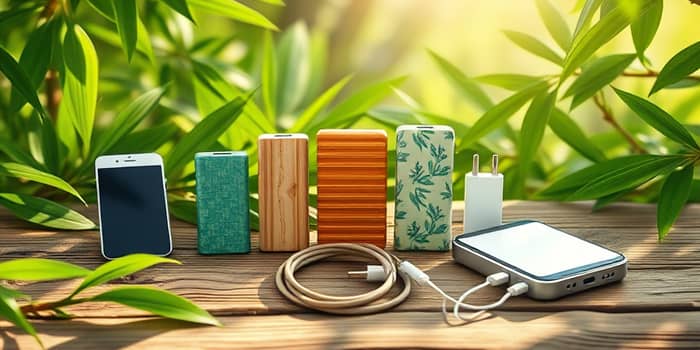As our dependence on smartphones continues to rise, so does the mountain of electronic waste generated by outdated, plastic-laden chargers. Fortunately, a new generation of biodegradable phone chargers is proving that sustainability and high performance can go hand in hand.
The E-Waste Crisis and the Need for Change
Today, over 50 million metric tons of electronic waste are produced worldwide each year, with chargers and cables representing a significant portion of discarded items. Conventional chargers, typically made from non-recyclable plastics and electronic components, often end up in landfills—leaching toxins into soil and water.
Environmental advocates warn of the long-term consequences: heavy metals, such as lead and cadmium, can contaminate ecosystems, while microplastics accumulate in food chains. The sheer scale of this problem has sparked an urgent search for greener alternatives that do not sacrifice reliability.
Decoding Biodegradable Chargers: Materials and Standards
At the heart of biodegradable chargers are materials engineered to break down harmlessly at end of life. Bamboo, recycled aluminum, and cutting-edge bioplastics are leading the charge. Bamboo, in particular, offers exceptional durability and natural antibacterial properties, making it a preferred choice for eco-conscious manufacturers.
Meanwhile, industry-wide adoption of wireless charging standards has accelerated. The Qi2 standard ensuring fast charging and broad compatibility now powers over 1.5 billion devices globally. Chargers bearing the Qi2 Ready logo guarantee seamless alignment and efficient power transfer, all while embracing sustainable construction.
Innovations Driving the Sustainable Charging Revolution
Manufacturers have introduced a host of design breakthroughs to enhance both performance and repairability. Biodegradable insulation wraps delicate wiring in plant-based polymers, while connectors are designed for simple replacement rather than whole-unit disposal.
These modular designs for easier upgrading allow users to swap out worn cables or outdated components, extending product lifespans and reducing waste. On the factory floor, energy-efficient production processes and the use of 85–90% post-consumer recycled plastics in certain models have cut carbon emissions by up to 84.8% compared to traditional methods.
- Biodegradable insulation from plant-based polymers
- Repairable components to prolong charger lifespans
- Modular, upgradeable parts for reduced e-waste
Leading Brands Delivering Performance and Style
Several pioneering companies have emerged, marrying eco-friendly design with top-tier charging speeds. EcoBlvd, for instance, offers bamboo wireless pads that deliver 15W fast charging and a free recycling scheme that incentivizes responsible disposal.
Belkin’s 2025 lineup boasts chargers built with up to 90% PCR plastics, including 50W and 67W Dual USB-C wall units, 70W GaN technology, and high-capacity 20,000 mAh power banks. Their commitment to carbon footprint reduction efforts has earned industry accolades and a loyal customer base.
- EcoBlvd: Bamboo and recycled metal wireless chargers with recycling program
- Belkin: 50W–100W GaN chargers, 20K mAh power banks, PCR plastics use
- Nimble: Ethically sourced materials and transparent performance data
Eco-Friendly vs. Conventional: A Comparative Snapshot
Understanding how biodegradable chargers measure up against traditional models can guide eco-conscious purchases. The following table highlights key distinctions:
Beyond the Product: Environmental Impact and Circular Programs
Biodegradable chargers do more than reduce landfill volume. Their repairable connectors and modular design strategies empower consumers to replace only what’s worn out, slashing waste generation.
Circular programs, like EcoBlvd’s free take-back scheme, close the loop by collecting old devices and ensuring materials re-enter manufacturing cycles. Such initiatives demonstrate how industry leaders can blend innovation with responsibility to create lasting change.
Major brands are also investing in social and environmental projects. For every charger sold, EcoBlvd contributes to renewable energy nonprofits. These efforts underscore a broader shift toward corporate stewardship and collective impact.
The Road Ahead: Future Outlook for Sustainable Charging
The coming years promise even more strides in eco-friendly charging. Expect to see growing e-waste awareness driving innovation in connector materials, standardized USB-C and Qi2 adoption, and further improvements in energy efficiency.
Advances in biodegradable insulation and new circular design frameworks will likely redefine consumer electronics. As regulations tighten around e-waste and carbon emissions, brands that prioritize sustainability will stand out in a crowded market.
By choosing biodegradable phone chargers, individuals can make a tangible difference—reducing plastic pollution, conserving resources, and supporting a healthier planet. The era of eco-friendly charging is no longer a distant promise; it’s here, performing reliably and inspiring hope for a cleaner, more sustainable future.
References
- https://edsonsoon.com/blogs/articles-news/%F0%9F%94%8C-best-eco-friendly-chargers-in-2025-powering-devices-without-polluting-the-planet
- https://ausdroid.net/news/2025/01/06/belkin-unveils-eco-friendly-chargers-and-innovative-audio-products-at-ces/
- https://www.graniteriverlabs.com/en-us/industry-insights/qi2-ready-wireless-charging-2025
- https://www.gonimble.com
- https://cfeconn.com/connector-trends-in-2025-what-to-expect-in-the-world-of-charging-tech.html
- https://belvg.com/blog/why-go-green-top-20-eco-friendly-products.html
- https://www.ecoblvd.com/collections/bamboo-wireless-chargers
- https://www.kbb.com/car-advice/electric-cars-101/










